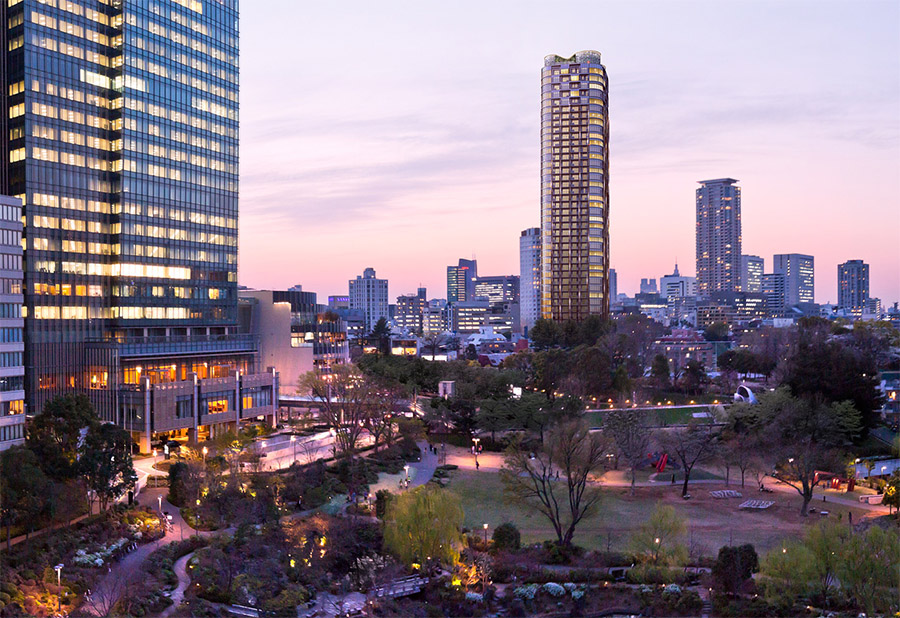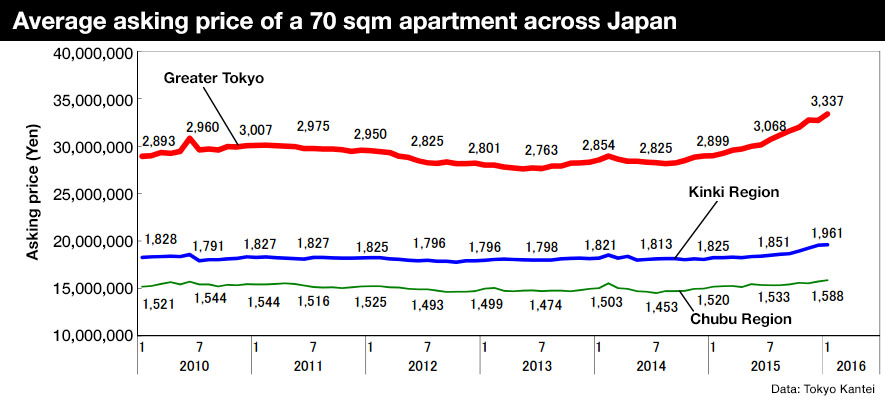Roppongi Hills apartment to be auctioned off after charity donation

The former owner of a 2-Bedroom apartment on the 19th floor in Roppongi Hills Residence B has donated the property to Oita Prefecture’s Board of Education as part of his estate. The late owner, who passed away in 2014, was the grandchild of the former principal of the Oita Prefecture School for the Blind.
The Board of Education held an open auction to sell the apartment, with the proceeds going to the prefecture. Bids were open until February 17th.
The minimum bid was set at 140,790,000 Yen (1.25 million USD), which works out to around 1,877,000 Yen/sqm (1,550 USD/sq.ft). Read more
Construction Co. to demolish 90-year old western-style house in Nagano

The historic Shinshu-Kaikan building in Nagano City will be demolished to make way for a 15-storey apartment building.
It was built as the residence of Kyushichi Kobayashi, the first president of the Nagano Jitsugyo Bank (which later merged to become the Shinano Bank). The actual year of construction is unknown, although it is estimated to be approximately 90 years old. The two-storey house included a fireplace, which was unusual for residences, as well as a slate roof.Read more
Brand new condominium prices in Japan reach 42-year high

The average price of a brand new condominium across Japan reached a 42-year high in 2015. According to the Real Estate Economic Institute, the average sale price of a brand new condominium across the country was 46,180,000 Yen (412,000 USD) in 2015, up 7.2% from 2014 and the highest price seen since the Institute began recording sales data in 1973.
The average price per square meter was 654,000 Yen (540 USD/sq.ft), up 8.5% from 2014. This is the 3rd year in a row to record a year-on-year increase. Although the total sale price reached a record high, the average price per square meter is still slightly below the peak of 667,000 Yen/sqm recorded in 1991.
The average price in Tokyo’s 23 wards was 67,320,000 Yen (600,000 USD), up 12.3% from 2014. The average price per square meter was 987,000 Yen (820 USD/sq.ft), up 13.1% from 2014.
In 2015, there were 1,688 brand new condos priced over 100 million Yen offered for sale in the greater Tokyo area, an increase of 85.9% from 2014, but still below the peak of 3,079 units in 1990. The most expensive new apartment sold in East Japan was a 203 sqm (2,184 sq.ft) penthouse apartment in the Kengo Kuma-designed Park Court Akasaka Hinokicho The Tower condominium in Akasaka, Tokyo. The apartment sold for 1.5 billion Yen (13.4 million USD), which resulted in a record-setting price per square meter of around 7.4 million Yen (6,130 USD/sq.ft). West Japan also saw the most expensive new apartment sale in the past 20 years when a penthouse apartment in a luxury condominium currently under construction alongside Kamo River in Kyoto sold for 749 million Yen (6.7 million USD), or around 2,440,000 Yen/sqm (2,000 USD/sq.ft).
Tokyo apartment asking prices increase for 19th consecutive month

According to Tokyo Kantei, the average asking price of a 70 sqm (753 sq.ft) second-hand apartment in greater Tokyo in January 2016 was 33,370,000 Yen, up 2.1% from the previous month and up 15.1% from January 2015. The average building age was 22.1 years.
In the Tokyo metropolitan area, the average price was 46,420,000 Yen, up 0.4% from the previous month and up 17.4% from last year. This is the 19th month in a row to see a month-on-month increase. The average building age was 21.7 years.
In Tokyo’s 23 wards, the average price was 51,620,000 Yen, up 0.4% from the previous month and up 17.3% from last year. This is also the 19th consecutive month to see a month-on-month increase. The average building age was 21.7 years.Read more
Sales of brand new 100 million Yen + condos triple in January
According to the Real Estate Economic Institute, 1,494 brand new apartments were released for sale in greater Tokyo in January, down 75.9% from the previous month and down 11.0% from January 2015. This is in line with the Institute’s forecast of 1,500 units.
876 apartments were sold, resulting in a contract rate of 58.6%, down 6.2 points from the previous month and down 16.3 points from last year. This is the first time since July 2008 that the contract rate has dropped to the 50% range. 75 apartments in 7 high-rise buildings (over 20 storeys) were offered for sale. The contract rate was 32.0%, down 28.2 points from January 2015.
One of the reasons for the lower contract rate is the relatively high prices which have been pushed up by rising construction costs and land prices. Developers are also taking a ‘wait-and-see’ approach to carefully time the release of apartments in order to avoid unsold inventory.
Meanwhile, 2,655 second-hand apartments were reported to have sold in January, which is triple the number of new apartment sales. Second-hand apartment transactions were also up 8.8% from January 2015.
Although the contract rate for new apartments was low across the board, demand remains strong in the top end of the market. In Tokyo’s 23 wards, 98 new apartments priced over 100 million Yen were offered for sale in January, up from 30 that were offered in January 2015. 83 apartments were sold, up from 28 sales in 2015, and resulting in a contract rate of 84.7%.Read more
Average rent in Tokyo takes a dip in January

According to Tokyo Kantei, the average monthly rent of a condominium in greater Tokyo was 2,567 Yen/sqm in January 2016, down 2.3% from the previous month but up 0.9% from January 2015. This is the first time in 5 months that the average rent has fallen below the 2,600 Yen/sqm line, and is due to both a smaller share of listings in the Tokyo metropolitan area, as well as a softening of the rental market. The average apartment size was 59.70 sqm and the average building age was 19.9 years.
In the Tokyo metropolitan area, the average monthly rent was 3,128 Yen/sqm, down 1.2% from the previous month but up 2.6% from last year. The average apartment size was 56.46 sqm and the average building age was 18.1 years.
In Tokyo’s 23 wards, the average rent was 3,280 Yen/sqm, down 0.9% from the previous month but up 3.1% from last year. The average apartment size was 55.79 sqm and the average building age was 17.5 years.Read more
Local group wants to curb speculative investment in Kyoto apartments

A citizen’s group in Kyoto is campaigning for the city to introduce regulations to curb the recent speculative buying of apartments in the history city. On January 22, the Kyoto Community Development Citizen Association submitted a proposal to Kyoto City’s Town Planning Department seeking counter-measures against an overwhelming increase in real estate prices.Read more
